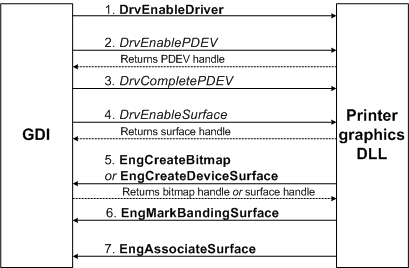Render a print job
Important
The modern print platform is Windows' preferred means of communicating with printers. We recommend that you use Microsoft's IPP inbox class driver, along with Print Support Apps (PSA), to customize the print experience in Windows 10 and 11 for printer device development.
For more information, see Modern print platform and the Print support app design guide.
Print jobs are either rendered as they are created, or they are written to a spool file as EMF records. In the case of EMF records, rendering takes place when the EMF print processor (localspl.dll) plays back the records. Rendering consists of a series of calls to the user-mode GDI drawing functions, beginning with CreateDC. The call to CreateDC is the first in a series of application calls that lead to a chain of actions involving the graphics rendering engine (GRE, also known as kernel-mode GDI), and the printer graphics DLL.
The following figure shows the interaction between kernel-mode GDI and the printer graphics DLL after CreateDC is called.

When an application calls the CreateDC function to create a printer device context, GDI checks to see if the appropriate printer graphics DLL is loaded. If it is not, GDI loads the DLL and calls the DrvEnableDriver function in the DLL. The function is not called again unless the driver is reloaded.
Next, GDI calls the printer graphics DLL's DrvEnablePDEV function so the driver can create a physical device instance and return device characteristics. GDI uses the returned information to create an internal description of the device instance.
GDI then calls the graphics DLL's DrvCompletePDEV function to supply a GDI handle to the device instance. The graphics DLL must use this handle as input to some of the Eng-prefixed callbacks provided by the GDI drawing engine (see GDI Support Services).
After GDI receives the device instance handle, it then makes a call to the graphics DLL's DrvEnableSurface function, which sets up the surface for drawing, and associates it with the physical device instance.
The driver can create a drawing surface for the device instance by calling EngCreateBitmap. Alternatively, if the drawing surface is device-managed, the driver can call EngCreateDeviceSurface.
If EngCreateBitmap cannot supply a bitmap large enough to contain an entire physical page, and if the driver supports page banding, EngMarkBandingSurface can be called to inform GDI that banding will be employed.
Finally, the EngAssociateSurface must be called to allow GDI to associate the created surface with a specified device instance, and to let GDI know which driver-supplied graphics DDI drawing functions (if any) it should call when it draws on this particular surface.
At this point, a drawing surface has been created and rendering can begin. The functions that GDI calls depend on whether banding is in effect.
Banding in use
For each document to be rendered when banding is used, GDI calls the following functions in the printer graphics DLL:
For each physical page
For each banding pass on a physical page
Rendering operations
DrvNextBand // Send raster data for this band, then clear surface to reuse with next band
Banding not in use
For each document to be rendered when banding is not used, GDI calls the following functions in the printer graphics DLL:
For each physical page
Rendering operations
DrvSendPage // Send raster data for the page
With the exception of DrvQueryPerBandInfo, these functions are intended to allow the printer graphics DLL to send control sequences to the printer hardware (by calling EngWritePrinter), and to perform any internal operations needed to initialize or complete processing of a document, page, or band.
The printer graphics DLL is responsible for sending the rendered image (that is, the contents of the drawing surface) to the printer at appropriate times (by calling EngWritePrinter), as follows:
For GDI-managed or device-managed bitmap surfaces
The drawing surface is a GDI-supplied or driver-supplied bitmap. The printer graphics DLL might hook some drawing functions (see Surface negotiation). If page banding is in use, the DrvNextBand function should send drawing surface contents. If banding is not in use, the DrvSendPage function should send the drawing surface contents.
For device-managed vector surfaces
The drawing surface is within the device. The printer graphics DLL hooks all drawing functions (see Surface Negotiation), and these functions send image data to the printer during rendering operations. Page banding is not used.
If you anticipate that any graphics DDI function provided by a printer graphics DLL could potentially take more than five seconds to execute, you should include code that calls EngCheckAbort at least every five seconds to see if the print job should be terminated.
After GDI calls DrvEndDoc to indicate that a document has been completely rendered, it calls DrvDisableSurface. If DrvEnableSurface called EngCreateBitmap, then DrvDisableSurface must call EngDeleteSurface.
GDI calls a printer graphics DLL's DrvDisablePDEV function when an application calls DeleteDC.
If an application calls ResetDC function during the printing of a document, GDI creates a new device context and calls the printer graphics DLL's DrvEnablePDEV function for the new context. Then GDI calls the DrvResetPDEV function, so the graphics DLL can update the new context with information from the old one. Next, DrvDisableSurface and DrvDisablePDEV are called for the old context, followed by DrvEnableSurface for the new context. Finally, GDI calls DrvStartDoc and rendering resumes on a new page.
GDI calls DrvDisableDriver prior to unloading the printer graphics DLL.
If printer hardware supports drawing operations that are not supported by GDI drawing functions, the printer graphics DLL can provide a DrvDrawEscape function.
A printer graphics DLL can provide a DrvEscape function if it is necessary to support drawing or nondrawing operations that are not available through GDI functions. For example, the Microsoft PostScript printer driver uses escapes to support PostScript injection points. Or, an application might need to obtain a fax machine's phone number. The DrvEscape function is also used for indicating the operations supported by the DrvDrawEscape function.